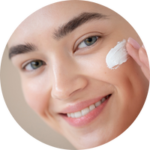Unlock the Secret to Glowing Skin: The Ultimate Skincare Guide
Unlock the Secret to Glowing Skin: The Ultimate Skincare Guide
Having radiant, glowing skin is a dream for many, but with the overwhelming number of products and advice available online, achieving that healthy glow can feel like an impossible task. The good news is, glowing skin isn’t just about slathering on expensive creams or trying every new skincare trend. It’s about understanding your skin, choosing the right products, and adopting consistent healthy habits.
In this comprehensive guide, we’ll break down the essential steps and tips you need to unlock your natural glow. From skincare routines to lifestyle adjustments, we’ve got you covered with everything you need to achieve beautiful, glowing skin.
Understanding Your Skin: Know Your Skin Type
Before diving into any skincare routine, it’s important to identify your skin type. Not every product is suitable for every skin type, and using the wrong products can lead to irritation, dryness, or breakouts.
There are five main skin types:
-
Normal Skin: This type is generally balanced with no excess oil or dryness. There are occasional breakouts, but overall, the skin feels comfortable.
-
Oily Skin: Oily skin tends to look shiny, particularly around the T-zone (forehead, nose, and chin). This skin type is more prone to acne, blackheads, and clogged pores.
-
Dry Skin: Dry skin may appear flaky or dull and feels tight, especially after cleansing. It lacks moisture, leading to rough patches and irritation.
-
Combination Skin: This skin type has both oily and dry areas. The T-zone might be oily while the cheeks or other areas are dry.
-
Sensitive Skin: Sensitive skin reacts easily to products and environmental factors, often becoming red, irritated, or itchy.
Tip: If you’re unsure of your skin type, wash your face and leave it free of makeup for about 30 minutes. Observe how it feels—tightness suggests dryness, while oiliness indicates oily skin.
Building the Perfect Skincare Routine
Creating an effective skincare routine is key to achieving glowing skin. Here’s a step-by-step guide to help you get started:
Step 1: Cleanse Your Skin
Cleansing is the foundation of any skincare routine. It removes dirt, oil, makeup, and other impurities that accumulate throughout the day, preparing your skin for the next steps in your routine.
-
For Oily/Acne-Prone Skin: Use a gel or foaming cleanser (e.g., CeraVe Foaming Cleanser or Neutrogena Oil-Free Acne Wash).
-
For Dry/Sensitive Skin: Opt for a hydrating, cream-based cleanser (e.g., La Roche-Posay Toleriane Hydrating Cleanser or Cetaphil Daily Facial Cleanser).
Make sure to cleanse your skin both in the morning and at night to keep it clean and refreshed.
Step 2: Tone
Toners help restore the skin’s pH balance and prepare the skin for the absorption of the next products. Modern toners also hydrate and soothe the skin.
-
Hydrating Toners: Look for ingredients like glycerin, aloe, or rosewater.
-
Exfoliating Toners: A toner with BHAs (like salicylic acid) or AHAs (like glycolic acid) can gently exfoliate your skin, improving its texture. Use these 2-3 times a week.
Step 3: Exfoliate (2-3 Times a Week)
Exfoliation is a critical step in removing dead skin cells, which can make your skin appear dull. Regular exfoliation promotes smoother, brighter skin by clearing clogged pores and stimulating new skin cell turnover.
-
Chemical Exfoliants: AHAs and BHAs are great for gently exfoliating the skin. AHAs (such as glycolic acid) help to remove dead skin on the surface, while BHAs (such as salicylic acid) penetrate deeper to unclog pores.
-
Physical Exfoliants: Avoid abrasive scrubs that may irritate the skin. Instead, choose gentle physical exfoliants with smooth, rounded particles.
Tip: Over-exfoliating can strip your skin of essential oils, leading to irritation. Stick to 2-3 times a week and listen to your skin’s needs.
Step 4: Apply a Serum
Serums are concentrated formulas designed to target specific skin concerns. From boosting hydration to reducing wrinkles, there’s a serum for every skin issue.
-
For Hydration: Choose serums with hyaluronic acid to plump and hydrate the skin.
-
For Brightening: Vitamin C serums can brighten dark spots and even out skin tone.
-
For Anti-Aging: Retinol or peptides are great for minimizing fine lines and promoting collagen production.
Serums are designed to penetrate deeply into the skin, so apply them after toner but before moisturizer.
Step 5: Moisturize
Moisturizing is key to keeping your skin hydrated and protecting its barrier. Even if you have oily skin, don’t skip this step—hydrating your skin prevents it from overproducing oil.
-
For Oily Skin: Opt for lightweight, non-comedogenic moisturizers that won’t clog your pores (e.g., Neutrogena Hydro Boost Water Gel).
-
For Dry Skin: Look for thicker, richer creams that contain nourishing ingredients like ceramides and fatty acids (e.g., CeraVe Moisturizing Cream).
Step 6: Sunscreen (AM Only)
Sunscreen is non-negotiable if you want glowing, healthy skin. UV rays are the number one cause of premature aging, including wrinkles and hyperpigmentation. Make sure to apply sunscreen every morning, even on cloudy days.
-
Broad-Spectrum SPF 30 or Higher: Choose a sunscreen with at least SPF 30 to protect against both UVA and UVB rays.
-
Top Picks: EltaMD UV Clear SPF 46 or La Roche-Posay Anthelios SPF 60.
Tip: Reapply sunscreen every two hours, especially if you’re spending time outdoors.
Advanced Skincare Tips for Maximum Glow
While a basic skincare routine can help you achieve glowing skin, certain advanced techniques and treatments can take your glow to the next level. If you’re looking to optimize your skincare regimen and address specific concerns like deep wrinkles, acne scars, or uneven skin tone, these additional steps might be the solution.
Incorporate Retinol Into Your Routine
Retinol, a derivative of vitamin A, is one of the most powerful ingredients in skincare for anti-aging and skin renewal. It accelerates skin cell turnover, which helps to prevent the build-up of dead skin cells, reduces the appearance of fine lines, and promotes smoother, more even skin.
-
How to Use Retinol: Introduce retinol slowly into your routine, starting with a lower concentration (e.g., 0.25% or 0.5%) 2-3 times a week to allow your skin to adjust. You can increase the frequency and strength of the retinol as your skin becomes accustomed to it.
-
Tip: Always apply retinol at night because it can make your skin more sensitive to the sun. Follow up with a moisturizer to prevent dryness and irritation.
Retinol can be a game-changer when it comes to glowing, youthful skin, but it’s important to start slow and listen to your skin.
Consider Professional Facials and Treatments
In-office treatments can give your skin the extra boost it needs to look radiant. Whether you’re dealing with acne, hyperpigmentation, or simply want a glow-up, professional facials and treatments can provide immediate and long-term results.
-
Chemical Peels: Chemical peels remove the outer layer of dead skin cells and encourage the growth of fresh, youthful skin. They can treat everything from acne scars to fine lines and pigmentation issues. You may experience some redness or flaking for a few days post-treatment, but the results are often well worth it.
-
Microneedling: This treatment involves tiny needles that create micro-injuries in the skin, prompting the body to produce collagen and elastin. Microneedling is particularly effective for improving skin texture and reducing scarring, helping your skin appear smoother and more radiant.
-
Laser Treatments: Laser therapies like fractional laser can target pigmentation, fine lines, and uneven texture, promoting a more even complexion. Laser treatments may require some downtime, but they can provide dramatic results.
Tip: Always consult with a licensed professional before undergoing any advanced treatments to ensure you choose the right option for your skin.
Natural Remedies for Radiant Skin
For those who prefer a more holistic approach to skincare, there are several natural remedies that can enhance your skin’s glow. While these remedies may not provide instant results like chemical treatments, they can be a gentle and nourishing addition to your skincare routine.
Aloe Vera
Aloe vera is renowned for its soothing and healing properties. It contains vitamins, minerals, and amino acids that hydrate and calm the skin, making it a great option for individuals with sensitive skin or those suffering from sunburns.
-
How to Use: Apply pure aloe vera gel directly from the plant or purchase organic aloe vera gel. You can use it as a mask, moisturizer, or a calming treatment after sun exposure.
Honey and Lemon Mask
Honey has natural antibacterial and moisturizing properties, making it ideal for both acne-prone and dry skin. When combined with lemon, which is packed with vitamin C, this mask can help brighten the skin and fight off dullness.
-
How to Use: Mix one tablespoon of raw honey with a few drops of fresh lemon juice. Apply to your face for 15-20 minutes before rinsing off with warm water.
Turmeric Face Mask
Turmeric is an antioxidant-rich spice that’s known for its anti-inflammatory properties. It can help reduce redness, pigmentation, and inflammation, making it a great natural option for glowing skin.
-
How to Use: Create a paste by mixing turmeric powder with honey or yogurt. Apply to your face for 10-15 minutes, then rinse off with lukewarm water. Be mindful, as turmeric can stain clothing or towels.
Green Tea
Green tea is rich in antioxidants, which help fight free radicals that cause premature aging. It can also calm inflammation and reduce redness.
-
How to Use: Brew a cup of green tea, let it cool, and apply the cooled tea to your skin with a cotton pad. Alternatively, you can use green tea-infused products to reap the benefits.






